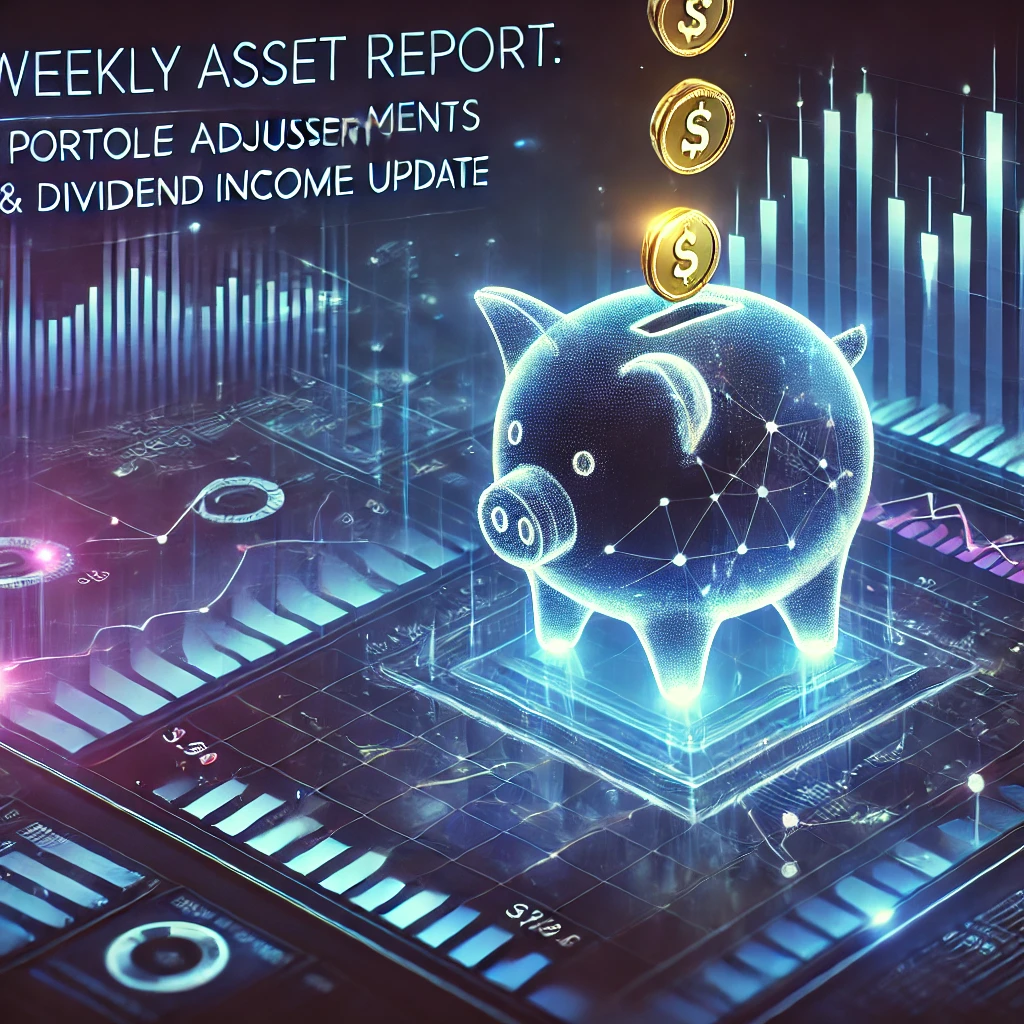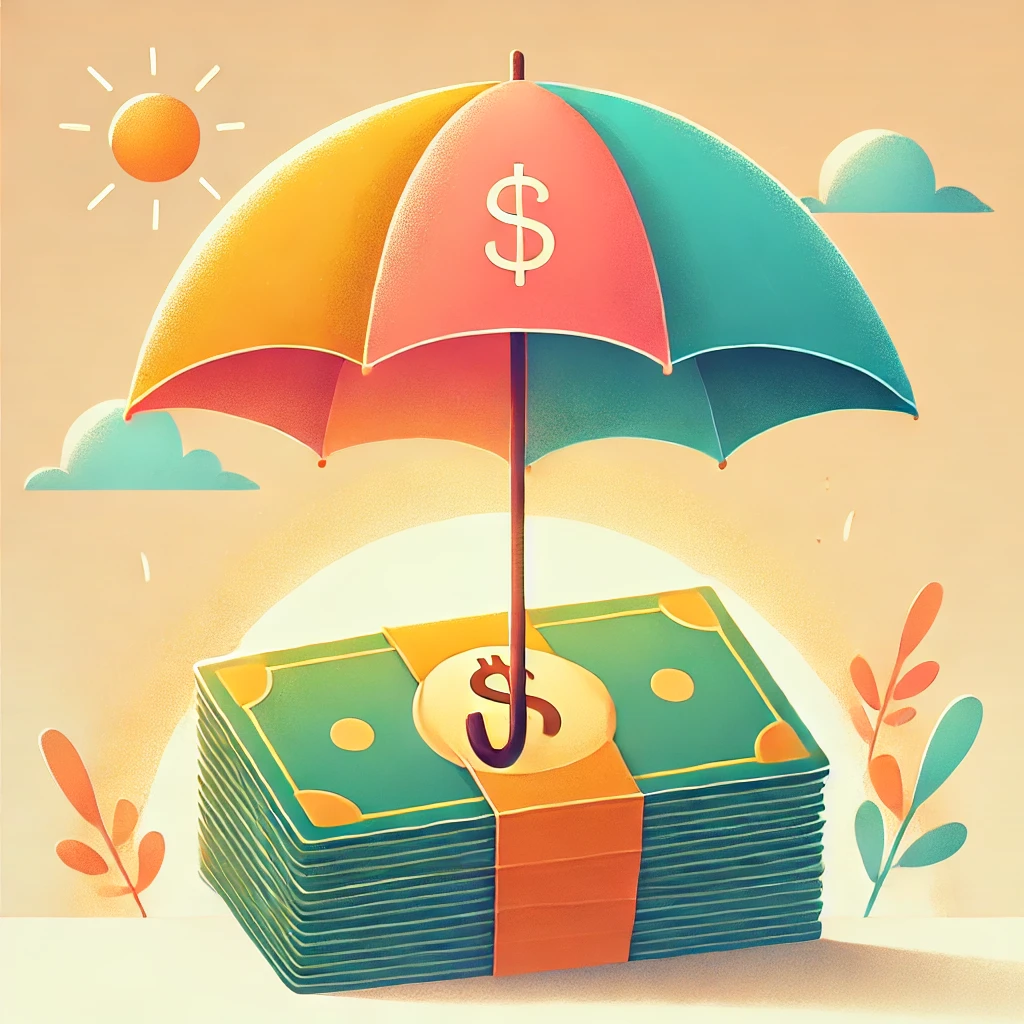「挑戦する投資家がたどり着く配当ライフ」
Weekly Asset Report: Portfolio Adjustments & Dividend Income Update
2025/2/8
Every Sunday, I provide a weekly asset report to track my financial progress. In this update, I’ll cover the following key topics: Let’s dive into this week’s financial overview. 1. Asset Breakdown & Changes Cash Holdings Stock Investments Mutual Funds Retirement Funds Reward Points 2. Total Asset Overview Total Asset Change: -1.61% This week’s decline was mainly due to: Key takeaway: 3. Market Trends & Economic News Key Market Factors This Week The main market influence this week was yen appreciation. Given the uncertain environment, increasing cash reserves was a risk-conscious decision. The next step is to assess whether the yen will continue strengthening or if it will rebound. Major Economic Events: 4. Dividend Income Update Dividend Received This Week: ¥41,124 Despite market fluctuations, I received dividends from one major company this week. Company Clues: Year-to-Date Dividend Progress: Dividend Growth Over Time: Month Dividend (¥) Cumulative (¥) Goal Progress (%) January 293,624 293,624 9.79% February 41,124 334,748 11.16% This steady progress reassures me that my dividend-focused strategy is working. 5. Portfolio Restructuring & Investment Strategy Why I Increased Cash Holdings Portfolio Adjustments: Key Takeaways New NISA Investments New Stock Purchases (Hints): Stock Industry Growth Factors Dividend Characteristics Portfolio Contribution Stock 1 Industrial & Energy Global economic recovery & infrastructure investment Stable and consistent payouts Enhances cash flow stability Stock 2 Chemical & Plastics Economic rebound & new technology adoption High dividend yield Strengthens portfolio resilience Final Thoughts: Market Outlook & Strategy This week, my portfolio saw a temporary dip, but the strategic cash increase provides ...
How Investing Changed My Life: From Gambling to Financial Freedom Through Dividend Reinvestment
2025/2/7
Before I discovered stock investing, I used to think of it as a form of gambling, something for the rich, or something that was out of reach for someone like me—a salaried worker making under $50,000 a year. However, if I had never taken action, I wouldn’t have built the $300,000 in assets I have today, nor would I be running my blog. Investing doesn’t just change your financial situation. It opens doors to valuable knowledge about money, time management, self-investment, and ultimately expands the choices you can make in life. In this article, I’ll explain how stock investing and dividend reinvestment completely transformed my perspective on money and helped me achieve financial freedom. How I Discovered the Power of Dividend Reinvestment My journey into investing began with Japanese stocks, but I was soon introduced to the concept of dividend reinvestment in U.S. stocks, which completely shifted my approach to investing. The Shock of Earning $1,000 in Dividends When I first started investing, my main goal was capital gains (profit from price appreciation). However, after learning about the power of dividend reinvestment, I earned $1,000 in dividends in my first year of applying this strategy. This experience was eye-opening. Before, I had always believed that money could only be earned by working. But suddenly, money was coming to me effortlessly—this was a game-changer. The Shift in My Mindset Around Money As my dividends grew, I started thinking about how to make the most of this passive income. I realized that investing wasn’t just about accumulating ...
2025/2/6
"Japanese Stocks vs U.S. Stocks: Dividend Strategies, Differences, and My Investment Decisions" In this article, we will explain By reading this article, you'll understand the differences between Japanese and U.S. stocks and gain insights on how to approach your investment strategy. Be sure to read through to the end and use this as a reference for your investment decisions! The Difference in Dividend Stability between Japanese and U.S. Stocks 1. Features of Japanese Stocks Japanese companies tend to increase their dividends significantly when their performance is good, but they also quickly cut dividends or even eliminate them when performance deteriorates. This means that dividends for Japanese stocks are highly sensitive to economic conditions and corporate performance. For example, during recessions such as the Lehman Brothers crisis or the COVID-19 pandemic, many companies opted for dividend cuts or suspensions. 2. Features of U.S. Stocks On the other hand, U.S. companies prioritize maintaining stable dividends and increasing them over time. A significant number of "Dividend Aristocrats"—companies that have increased their dividends every year for decades—exist in the U.S. Some of these companies have increased dividends for over 50 years. Examples include Coca-Cola (KO) and Johnson & Johnson (JNJ). These companies prioritize maintaining or increasing dividends even during economic downturns. The PBR (Price-to-Book Ratio) Issue and How Companies Are Responding In the Japanese stock market, the issue of companies' PBR (Price-to-Book Ratio) falling below 1 has attracted attention. PBR is an indicator that shows how much value the stock market places on a company's assets (book value). When ...
9% High Dividend Stock Falls to Zero…! 3 Lessons I Learned & How to Avoid Investment Risks
2025/2/5
[High Dividend Investing Pitfalls] What I Learned from a Dividend Cut – The “High Yield Trap” Explained What You Will Learn from This Article ✅ What is the "dividend cut risk" of high dividend stocks?✅ Characteristics of stocks that fall to zero dividends and how to identify them✅ Why choosing based on yield alone is dangerous & how to pick safer stocks✅ When to cut losses and the importance of risk management Many investors assume that high dividend stocks = stable income, but the reality is that some of these stocks carry the risk of falling to zero dividends (dividend cut). I personally experienced this early in my investing journey when I invested in Lumen Technologies (LUMN)—a high-yield stock that ultimately cut its dividend and saw its stock price collapse. That painful lesson helped me recognize risks more effectively. So when I saw the recent NextEra Energy Partners (NEP) dividend cut news, I realized that if I had owned the stock, I would have certainly sold it immediately. In this article, I will share my real-life experience and how to identify stocks at risk of cutting dividends. If you are already investing in high-yield stocks or considering it, these insights will help you avoid unnecessary losses and make better investment decisions. 1. My Costly Mistake: Lumen Technologies (LUMN) Dividend Cut When I first started investing in high-dividend U.S. stocks, I bought Lumen Technologies (LUMN), a telecom company that appeared to be a solid investment. 📌 Lumen Technologies (LUMN) Company Overview Category Details Company Name Lumen ...
2025/2/3
What You’ll Learn from This Article ✅ How to reach 50 million yen (semi-wealthy status) in just 3–4 years✅ A realistic wealth-building strategy that even an ordinary salaryman can follow✅ A detailed simulation of investment amounts, returns, and dividend growth✅ How to manage risks, including market crashes and dividend cuts “Could I do this too?”By the time you finish reading, you’ll have a clear picture of how this strategy works! Introduction: Can an Ordinary Salaryman Really Build 50 Million Yen in Wealth? When people hear “50 million yen in assets” (semi-wealthy class), they often assume it’s only achievable for high-income professionals or entrepreneurs.However, I’m just an ordinary salaryman with a family—not a high earner. Even so, with smart risk management and strategic investing, I believe it’s possible to reach semi-wealthy status within 3 to 4 years.But simply saving and passively investing won’t get you there. You need to be proactive: ✅ Rebalancing your portfolio✅ Cutting losses on underperforming stocks✅ Strategically increasing investments and optimizing asset allocation✅ Knowing when to take profits This article covers: ✅ My current financial situation and goals✅ A detailed simulation of how long it will take to reach 50 million yen✅ The impact of shifting from a high-risk 9% return strategy to a stable 5% approach✅ Key risks and how to mitigate them By the end, you’ll have a step-by-step roadmap that even a regular salaryman can follow to grow wealth!Let’s dive into the specifics. My Current Financial Status & Goals Here’s where I currently stand: Category Current Status Target (in ...
2025/2/3
Before Investing, I Was 100% Focused on Saving After graduating from university, I worked in the service industry, earning less than 200,000 yen per month. Despite this, I managed to save nearly 10 million yen (around $70,000) in just six years. The key to my success was living at home and following a strict saving rule. I limited my monthly personal expenses to 30,000 yen ($200), putting everything else into savings. Instead of focusing on making more money, I first mastered the art of saving. Later, I used my savings to start investing and growing my assets. Now, in my late 30s, I have the financial freedom to make different career and life choices. In this article, I’ll share:✅ How I saved 10 million yen in six years✅ The lifestyle and habits that made it possible✅ How saving money led to bigger financial opportunities 1. Maximizing the Benefits of Living at Home The biggest factor in saving 10 million yen was the low cost of living at home. Let’s compare typical living expenses for someone living alone in Japan: Expense Monthly (Average) Yearly Rent 60,000 yen 720,000 yen Utilities 10,000 yen 120,000 yen Food 30,000 yen 360,000 yen Internet & Phone 8,000 yen 96,000 yen Total Approx. 110,000 yen Approx. 1.3 million yen By living at home, I was able to redirect this 1.3 million yen per year into savings. Key Considerations When Living at Home: By taking advantage of this unique opportunity, I was able to build significant savings quickly. 2. The 30,000-Yen Monthly ...
2025/2/1
1. Introduction | Reviewing This Week’s Asset Performance and Investment Strategy Last week, despite market volatility, my portfolio remained relatively stable.This week, we’ll take another deep dive into total asset movement, dividend earnings, and the impact of market trends to keep our investment strategy sharp. One key focus this time: "How to Use Dividends Effectively."While reinvesting dividends is the standard approach, we’ll explore alternative ways to utilize them for enhancing lifestyle and financial security. Let’s dive into this week’s asset report! (Check out last week's article here!) 2. Total Asset Trends and Analysis (1) This Week’s Total Asset Movement This week, my total assets showed a slight -0.06% decline. However, looking closer, my stock holdings increased, suggesting that the drop wasn’t significant. 3. Market Influences & Investment Adjustments Deep-Sea Shock Impact Markets experienced temporary chaos and volatility, but ultimately, stock prices rebounded.This reaffirmed the importance of staying calm and not panic-selling during downturns. Instead, such moments present great buying opportunities for strong companies. Effect of U.S. Interest Rate Hikes Higher interest rates put short-term pressure on high-yield stocks, but their long-term income potential remains strong.Since my portfolio is designed for stable cash flow, I don’t plan any major adjustments yet. USD/JPY Exchange Rate Fluctuations While exchange rate movements are unavoidable, a weaker yen boosts the value of dollar-denominated assets.Despite short-term volatility, my long-term diversified portfolio should continue benefiting from currency fluctuations. 4. Future Investment Strategies Regular Portfolio Review (Every 3 Months) I already conduct quarterly portfolio assessments, which I’ll continue to fine-tune.Balancing risk and stability ...
Why I Keep Six Months’ Worth of Emergency Funds
2025/2/1
[In-Depth Guide] Balancing Aggressive Investing and Emergency Funds for Financial Success Introduction When building wealth through investing, a common question arises: How much emergency fund should I keep? As investment portfolios grow, many investors begin to wonder:"Wouldn't it be more efficient to allocate more capital into investments rather than keeping cash?" While taking on more risk can accelerate short-term gains, it also introduces instability and potential long-term pitfalls. Through my own investing journey, I’ve come to recognize the crucial importance of maintaining emergency funds and striking the right balance between investing and financial security. In this article, I’ll dive into: By the end, you’ll have a comprehensive investment strategy to ensure long-term stability while maximizing growth. 1. The Risks of Over-Investing: Why You Need Balance Many investors are tempted to allocate all available funds into investments to maximize returns. However, failing to maintain a cash buffer can lead to serious consequences when unexpected expenses arise. Risks of Investing Too Aggressively Investment Behavior Potential Risk Cutting emergency funds to invest more Unable to cover sudden expenses, forcing liquidation of investments at a bad time Overusing leverage High risk of forced liquidation during market downturns Relying too much on dividends Dividend cuts can disrupt expected income, creating financial stress For example, if you don’t maintain sufficient cash reserves and an emergency expense occurs (e.g., medical bills, home repairs), you might be forced to sell stocks at a market low—turning a temporary dip into a permanent loss. Leverage can also be dangerous. During the COVID-19 crash (2020) and ...
Managing Household Finances in the Era of Rising Mortgage Rates
2025/1/29
Managing Household Finances in the Era of Rising Mortgage Rates Recently, there has been a lot of news about rising mortgage interest rates. In particular, the Bank of Japan’s decision to increase rates by 0.5% has raised concerns for those with variable-rate mortgages, as it may lead to higher monthly payments. In this article, I’ll explain how to prepare for the reality of rising rates and share how my family is handling the situation. 1. Impact of Rising Interest Rates 1.1. The Bank of Japan’s Interest Rate Hike and Its Impact The Bank of Japan raised its policy interest rate by 0.5%, which has affected households with variable-rate mortgages. Major banks have increased base interest rates by about 0.25%, which will apply from April 1, and the new rates are expected to be reflected in mortgage payments starting in July. 1.2. Increase in Mortgage Payments Let’s take a look at how the rate hike will affect mortgage payments. Here’s an example scenario: If the interest rate increases by 0.25% (from 0.25% to 0.5%): If the interest rate increases by 0.5% (from 0.25% to 0.75%): If the interest rate increases by 1.0% (from 0.25% to 1.25%): As you can see, even a small increase in the interest rate can significantly impact monthly payments. For those with variable-rate mortgages, these changes can have a big effect, so it’s important to prepare in advance. 2. Key Principles for Managing Household Finances 2.1. Don’t Overestimate the Current Situation Currently, my family rents, so we aren’t directly affected by rising ...
2025/1/28
The COVID-19 Crash and the Investor’s Test: Lessons Learned from a Historic Market Downturn In 2020, the COVID-19 pandemic caused unprecedented global economic turmoil, presenting a major challenge for investors worldwide. As the markets plunged and circuit breakers were triggered repeatedly, I faced a pivotal moment as an investor where my ability to remain calm was truly tested. In this article, I’ll share my raw emotions during that time, a comparison to past market crashes, and the invaluable lessons I learned from this experience. If you haven’t already, I recommend checking out last week’s article: Chaos on the Day of the Circuit Breakers: Watching the Market Panic Live During the COVID-19 crash, circuit breakers (temporary halts in trading) were triggered multiple times. I vividly remember watching live market coverage on YouTube. The atmosphere was chaotic, and commentators expressed confusion, repeatedly admitting, "We have no idea what will happen next." As stock prices continued to plummet and trading paused, the tension was palpable. Adding to the chaos, oil prices briefly turned negative—a historic event. I experienced a mix of fear and excitement, realizing, “This is a moment for the history books.” Amid this turmoil, many investors succumbed to panic selling, exiting the market entirely. Placing the COVID-19 Crash in Historical Context To better understand the unique nature of the COVID-19 crash, let’s compare it to previous major market downturns: Crash Name Date Decline (%) Recovery Period (Months) Black Monday October 1987 ~22.6 ~3 Dot-com Bubble Burst March 2000 ~49.1 ~25 Global Financial Crisis September 2008 ~56.8 ...


!["9% Yield: An Overzealous Investor's Perspective on Japanese vs U.S. Stock Dividend Strategies [2025 Edition]" 3 IMG 3237 1](https://divre-life.com/wp-content/uploads/2025/02/IMG_3237-1.webp)



![[2025 Latest] How I Used My ¥293,624 in Dividends & The Risk of High-Yield Stocks Cutting Payouts | January Total Asset Analysis 6 DALL·E 2025 02 01 13.29.21 A warm and inviting digital illustration representing financial growth and dividend investing. The image features a friendly and calm setting with a p](https://divre-life.com/wp-content/uploads/2025/02/DALL·E-2025-02-01-13.29.21-A-warm-and-inviting-digital-illustration-representing-financial-growth-and-dividend-investing.-The-image-features-a-friendly-and-calm-setting-with-a-p.webp)


![[Reflection] "A 3 Million Yen Loss in the COVID-19 Crash… Why I Still Chose to Buy More and Work Towards a Dividend Lifestyle" 9 1DD7BF5D BA37 4DEB A9BB FD4B67A367CE 1](https://divre-life.com/wp-content/uploads/2025/01/1DD7BF5D-BA37-4DEB-A9BB-FD4B67A367CE-1.webp)